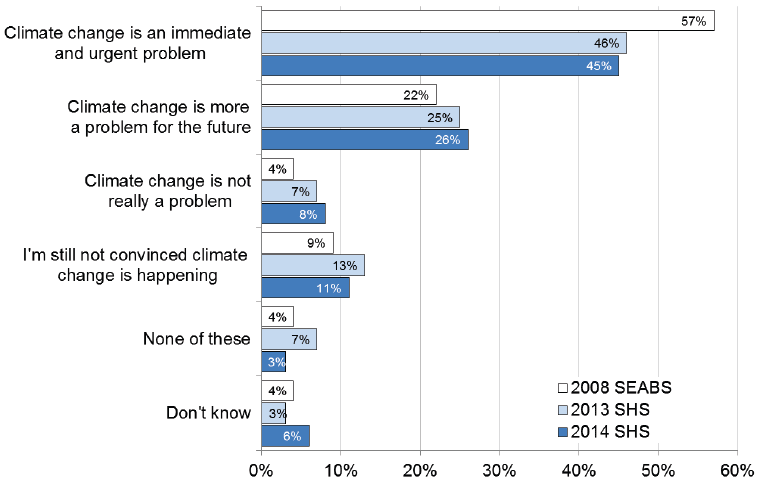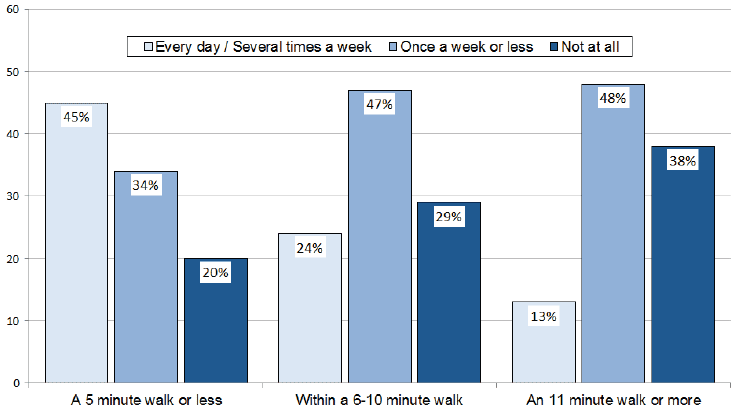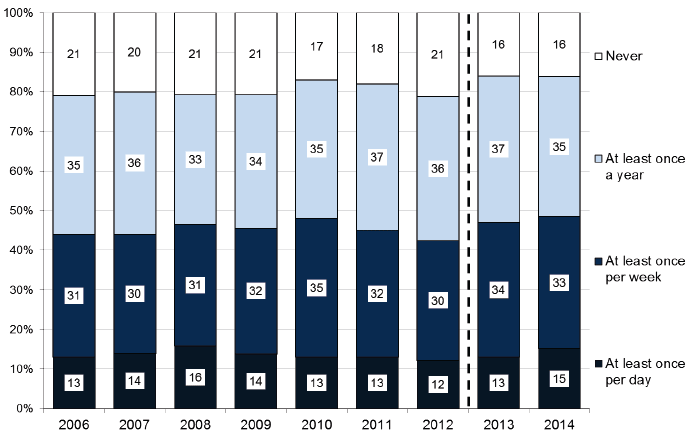Key Scottish Environment Statistics 2015
This publication aims to provide an easily accessible reference document which offers information on a wide range of environmental topics. It covers key datasets on the state of the environment in Scotland, with an emphasis on the trends over time wherever possible. The data are supplemented by text providing brief background information on environmental impacts and data source, a summary of the trend and brief information on the potential factors affecting the trend.
This document is part of a collection
Public Attitudes & Behaviours
Background
The attitudes which people hold towards environmental issues influences their behaviour with regards to the environment. In turn, the way in which a person interacts with their environment can have a positive effect on that individual and the environment itself, for example increasing outdoor activity may improve the health of the individual, and lead them to support environmental measures. Changes in attitudes can be encouraged with public initiatives, and the conversion of positive attitudes to positive behaviour can be aided by ensuring that provision of appropriate resources are available to the public.
Scottish Household Survey

The Scottish Household Survey is a large annual survey which collects a wide range of information on the status and views of people and homes in Scotland. It is a vital tool to evaluate the effectiveness of policy and the composition, characteristics, attitudes and behaviour of households and individuals at national and sub-national level.
Households are selected at random to take part in the survey, the major part of which is split into two separate modules. These are the Household survey, where questions are asked of the householder with the highest income, and the Random Adult survey, where a person aged over 16 in the household is selected to answer another set of questions. It is designed to be representative of Scottish society as a whole.

The survey began in 1999, and many of the questions in SHS are asked for many years in a row, giving us a view of how the indicator is changing over time. Nearly 10,000 people are surveyed each year in order to give a good coverage down to Local Authority level and an indication of important social demographics in Scotland.
Each year the SHS reports its findings in an annual report, detailing the key results across a wide range of features.
Targets and Indicators
- Visits to the Outdoors is a National Indicator for Scotland
- Perceived immediacy of Climate Change is one of the low carbon attitude and behaviour related indicators set out in 'Low Carbon Scotland': A Behaviours Framework'
Perceived Immediacy of Climate Change: 2008, 2013 and 2014
Which of these views, if any, comes closest to your own view about climate change?

Why this measure is important
Action to address climate change is a high priority for the Scottish Government, and the Climate Change (Scotland) Act (2009) set targets to reduce Scotland's greenhouse gas emissions. Public attitudes about the immediacy of climate change as a problem for Scotland is likely to influence their willingness to support initiatives to address climate change, including changing their own behaviour.
Background
From 2013 onwards, the Scottish Household Survey included a question about attitudes towards climate change. The same question had been asked in the Scottish Environmental Attitudes and Behaviours Survey 2008, so the results can be compared, although the surveys were slightly different. Respondents were presented with four statements about climate change and asked which, if any, was closest to their own view.
Trend
Since 2008 there has been a decrease in the number of people who view climate change as an immediate and urgent problem for Scotland.
Factors affecting trend
Weather patterns - including specific events such as flooding as well as media coverage, may influence people's views on climate change. The 2008 survey followed 5 years where mean temperature was higher than in any other year in the period 1910- 2002, while the mean temperature in 2010 was the 10th coldest on record and the lowest since 1986. On the other hand mean temperature in 2014 was the highest recorded.
Source: Scottish Government / Scottish Government | Metadata
Frequency of Use of Local Greenspace: 2014
Frequency of use of nearest usable greenspace (percentage of adults)

Why this measure is important
Having easy access to good greenspaces can improve people's quality of life by increasing their satisfaction with their neighbourhood, promoting physical health and mental wellbeing (including through the association between greenspace and increased physical activity), and reducing health inequalities.
Background
The Scottish Household Survey collects data on how accessible people's nearest usable greenspace is from their home (measured in terms of the time taken to walk there), and how often they use it.
Trend
Visits to greenspace and proximity to nearest greenspace is generally stable between years, with those living closest visiting their local greenspace more frequently. In 2014 around 37% of adults reported that they visited their nearest greenspace at least several times a week, compared to 36% in 2013.
Factors affecting trend
Older people visit greenspaces less often, so an aging population may affect the trend in the longer term.
Source: Scottish Government | Metadata
Percentage of adults making visits to the outdoors

Why this measure is important
Outdoor recreation is beneficial for health and well-being. It also provides opportunities for people to come into contact with, and increase their understanding of, the natural environment. This indicator provides a useful measure of the numbers of people who gain benefit from nature and biodiversity and potentially improve their understanding of the natural environment.
Background
The data are taken from a sample of randomly selected adults in the Scottish Household Survey who are asked how often they visit the outdoors in Scotland. Prior to 2012 the data was sourced from the Scottish Recreation Survey produced by Scottish Natural Heritage, which included the same question[18]. The Scottish Government has established a National Indicator[19] to increase the proportion of adults making one or more visit to the outdoors per week.
Trend
Visits to the outdoors have remained roughly stable over time, but does tend to change by a few percentage points each year. During 2014, 48% of adults are estimated to have made visits to the outdoors one or more times per week, compared to 46% in 2013.
Factors affecting trend
There are a variety of factors and influences for the level of outdoor recreation which may have affected the number of visits made to the outdoors last year, such as the weather. Older people and people with a long standing illness or disability visit the outdoors once a week less often (32% and 36% respectively), so changes to demographics in Scotland can have an influence on the number of people visiting the outdoors.
Source: Scottish Government / Scottish Natural Heritage | Metadata
Contact
Email: Kirsty Ciclitira
There is a problem
Thanks for your feedback